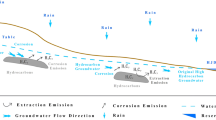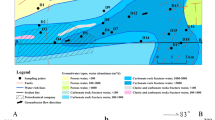Abstract
Original high hydrocarbon groundwater represents a kind of groundwater in which hydrocarbon concentration exceeds 0.05 mg/L. The original high hydrocarbon will significantly reduce the environment capacity of hydrocarbon and lead environmental problems. For the past 5 years, we have carried out for a long-term monitoring of groundwater in shallow Triassic aquifer in Northwest Guizhou, China. We found the concentration of petroleum hydrocarbon was always above 0.05 mg/L. The low-level anthropogenic contamination cannot produce high hydrocarbon groundwater in the area. By using hydrocarbon potential, geochemistry and biomarker characteristic in rocks and shallow groundwater, we carried out a comprehensive study in Dalongjing (DLJ) groundwater system to determine the hydrocarbon source. We found a simplex hydrogeology setting, high-level water–rock–hydrocarbon interaction and obviously original hydrocarbon groundwater in DLJ system. The concentration of petroleum hydrocarbon in shallow aquifer was found to increase with the strong water–rock interaction. Higher hydrocarbon potential was found in the upper of Guanling formation (T2g3) and upper of Yongningzhen formation (T1yn4). Heavily saturated carbon was observed from shallow groundwater, which presented similar distribution to those from rocks, especially from the deeper groundwater. These results indicated that the high concentrations of original hydrocarbon in groundwater could be due to the hydrocarbon release from corrosion and extraction out of strata over time.














Similar content being viewed by others
References
Belousova, A. P., Krainov, S. R., & Ryzhenko, B. N. (1998). Evolution of groundwater chemical composition under human activity in an oilfield. Environmental Geology, 38, 34–46.
Cai, C. F., Mei, B. W., Li, W., & Fan, G. (1997). Water–rock interaction in Tarim Basin: Constraints from oilfield water geochemistry. Chinese Journal of Geochemistry, 16, 289–303.
Chen, K. F., Kao, C. M., Chen, T. Y., Weng, C. H., & Tsai, C. T. (2006). Intrinsic bioremediation of MTBE-contaminated groundwater at a petroleum-hydrocarbon spill site. Environmental Geology, 50, 439–445.
Eman, A. A., Michael, Q., Amitabha, M., Andre, H., Adnan, A., Adel, A. H., et al. (2008). Extent and nature of hydrocarbon occurrence in the groundwater of Kuwait. Environmental Geology, 56, 877–889.
Feng, Q. Y., & Han, B. P. (2002). Hydrogeochemical simulation of water–rock interaction under water flood recovery in Renqiu oilfield, Hebei Procince, China. Chinese Journal of Geochemistry, 21, 156–162.
Huang, S. Y., Li, M. J., Zhang, K., Wang, T. G., Xiao, Z. Y., Fang, R. H., et al. (2016). Distribution and geochemical significance of phenylphenanthrenes and their isomers in selected oils and rock extracts from the Tarim Basin, NW China. Petroleum Science, 13, 183–191.
Hunt, J. M. (1996). Petroleum geochemistry and geology. Freeman and Company, 137(3), 313–314.
Jennifer, E. H., James, W. C., John, H. R., Cynthia, M. G., & James, E. M. (2011). Design and performance of pilot-scale constructed wetland treatment systems for treating oilfield produced water from Sub-Saharan Africa. Water, Air, and Soil Pollution, 223, 1945–1957.
Li, M., Lou, Z. H., Zhu, R., Jin, A. M., & Ye, Y. (2014). Distribution and geochemical characteristics of fluids in ordovician marine carbonate reservoirs of the Tahe oilfield. Journal of Earth Science, 25, 486–494.
Ma, J. Z., Pan, F., He, J. H., Chen, L. H., Fu, S., & Jia, B. (2011). Petroleum pollution and evolution of water quality in the Malian River Basin of the Longdong Loess Plateau, Northwestern China. Environmental Earth Sciences, 66, 1769–1782.
Mohialdeen, I. M. J., Hakimi, M. H., & Al-Beyati, F. M. (2013). Biomarker characteristics of certain crude oils and the oil-source rock correlation for the Kurdistan oilfield, Northern Iraq. Arabian Journal of Geosciences, 8, 07–523.
Pan, F., Ma, J. Z., Wang, Y. Q., Zhang, Y. L., Chen, L. H., & Edmunds, W. M. (2013). Simulation of the migration and transformation of petroleum pollutants in the soils of loess plateau: A case study in the maling oil field of Northwestern China. Environmental Monitoring and Assessment, 185(10), 8023–8034.
Su, X. S., Lv, H., Zhang, W. J., Zhang, Y. L., & Jiao, X. (2013). Evaluation of petroleum hydrocarbon biodegradation in shallow groundwater by hydrogeochemical indicators and C, S-isotopes. Environmental Earth Sciences, 69, 2091–2101.
Vaezian, A., Ziaii, M., Kamali, M. E., & Khaleghi, M. (2014). An evaluation on geochemical characteristics of some probable source rocks of Salman oil field in the Persian Gulf. Arabian Journal for Science and Engineering, 39, 5653–5663.
Walt, W., & Mcnab, Jr. (1999). Comparisons of geochemical signatures of biotransformation of fuel hydrocarbons in groundwater. Environmental Monitoring and Assessment, 59, 257–274.
Yasaman, R., Yoram, E., Reza, M. H., Mohamad, H. M. G., & Asadollah, M. (2016). Using inverse modeling and hierarchical cluster analysis for hydrochemical characterization of springs and Talkhab River in Tang-Bijar oilfield, Iran. Arabian Journal of Geosciences, 9, 241.
Acknowledgements
This research is financially supported by the project of groundwater environmental impact assessment for annual 600,000 tons polyolefin production chemical plant in Zhijin, Guizhou, China. The authors also want to thank the State Key Laboratory of Biogeology and Environment Geology and Key Laboratory of Tectonics and Petroleum Resources, Ministry of Education of China University of Geosciences, for technical supports during sample testing. We appreciate Prof. Shukui Zhu for helping the research. We also appreciate Professor Dave Yuan and Doctor Wenwen Chen for discussions.
Author information
Authors and Affiliations
Corresponding author
Electronic supplementary material
Below is the link to the electronic supplementary material.
Rights and permissions
About this article
Cite this article
Liu, S., Qi, S., Luo, Z. et al. The origin of high hydrocarbon groundwater in shallow Triassic aquifer in Northwest Guizhou, China. Environ Geochem Health 40, 415–433 (2018). https://doi.org/10.1007/s10653-017-9923-8
Received:
Accepted:
Published:
Issue Date:
DOI: https://doi.org/10.1007/s10653-017-9923-8




